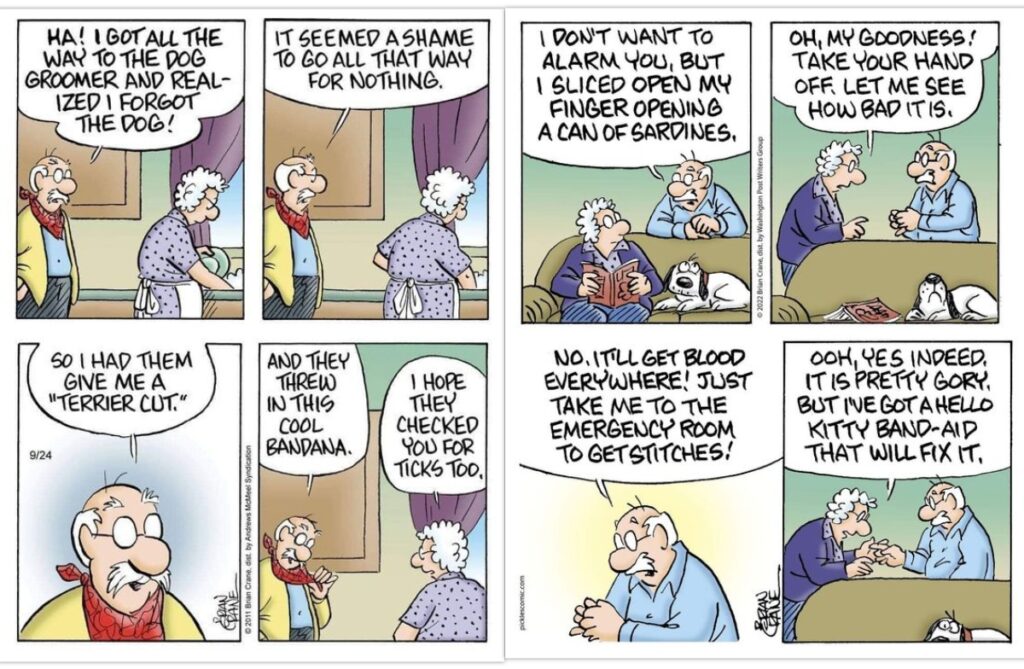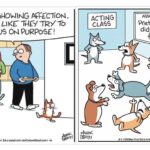Introduction to Pickles Comics
Pickles is a popular comic strip created by Brian Crane that has been capturing the hearts of readers since its inception in 1990s. The strip revolves around Earl and Opal Pickles, a Aged couple who navigate the twilight years of their lives with humor, love, and a fair share of mischief. What sets Pickles apart from other comic strips is its unique blend of relatable humor and insightful observations about aging, family dynamics, and the quirks of everyday life. The strip’s consistent quality and Crane’s keen eye for the subtleties of elderly life have solidified Pickles’ place in the pantheon of beloved comic strips.
The Characters and Themes of Pickles Comics
At the core of Pickles comics are its vibrant characters. Earl and Opal are not your typical retirees; they are full of life, wit, and a little bit of stubbornness. The supporting cast, including their pet dog Roscoe and their grandson Nelson, adds depth and variety to the comic’s narrative. Brian Crane excels at exploring themes of aging, marriage, and intergenerational relationships with a gentle humor that resonates with readers of all ages. The comic strip often delves into the minor yet significant moments of life, portraying them in a way that is both humorous and heartwarming.
The Art and Humor of the Comics Strip
The art style of Pickles is simple yet expressive, perfectly capturing the essence of the characters and their situations. Crane’s artwork complements the comic’s humor, using visual gags and expressions to enhance the storytelling. The humor in Pickles is subtle but effective, often derived from the everyday interactions between Earl, Opal, and their family. The comic strip excels in finding the comedy in the mundane, turning ordinary situations into moments of laughter and joy. The relatable nature of the humor is a testament to Crane’s understanding of his characters and his audience.
The Impact of Pickles Comics
Over the years, Pickles has garnered a devoted following, thanks in part to its universal appeal and consistent quality. The comic strip has not only provided readers with daily laughter but has also offered a unique perspective on the later stages of life. Through his work, Brian Crane has highlighted the joys, challenges, and undeniable humor that come with aging. Pickles serves as a reminder that life, regardless of one’s age, is full of moments worth smiling about. The comic’s ability to connect with readers on a personal level is a rare quality that distinguishes Pickles in the world of comic strips.
1

The image is a four-panel comic strip from “Pickles” by Brian Crane. In the first panel, a young boy, Nelson, admits to his grandmother, Opal, that he told her a lie. Opal, looking surprised, asks what it was. In the second panel, Nelson confesses that he didn’t really like her broccoli casserole, contrary to what he had told her earlier. Opal responds with a simple “You didn’t?”
In the third panel, Opal acknowledges that Nelson did the right thing by telling her the truth. In the final panel, Nelson explains that he told the truth because he knew if he didn’t, she would probably make the casserole again. The humor lies in the honest and practical reason behind Nelson’s confession—he wanted to avoid eating the casserole in the future. The strip showcases a light-hearted family interaction that highlights honesty and the relatable desire to avoid unwanted food.
2

The image shows a four-panel comic strip from “Pickles” by Brian Crane. In the first panel, a woman comments to Opal, the grandmother character from Pickles comics, that she has been doing a lot of shopping, as indicated by the many gift-wrapped packages she’s holding. In the second panel, Opal confirms that she has bought several gifts for her husband, referring to him affectionately as “my sweetie.”
In the third panel, the woman expresses admiration, saying Opal must really adore her husband because of all the gifts. The final panel delivers the punchline: Opal looks at a single, small gift and considers that maybe she should get something more for Earl, her husband. This suggests that all the gifts she bought were actually for herself, and the small item was the only one for Earl, humorously subverting the expectation set up in the previous panels. The comic strip uses this situation to playfully address the common theme of gift-giving in relationships, with a twist typical of the humor found in Pickles comics.
3
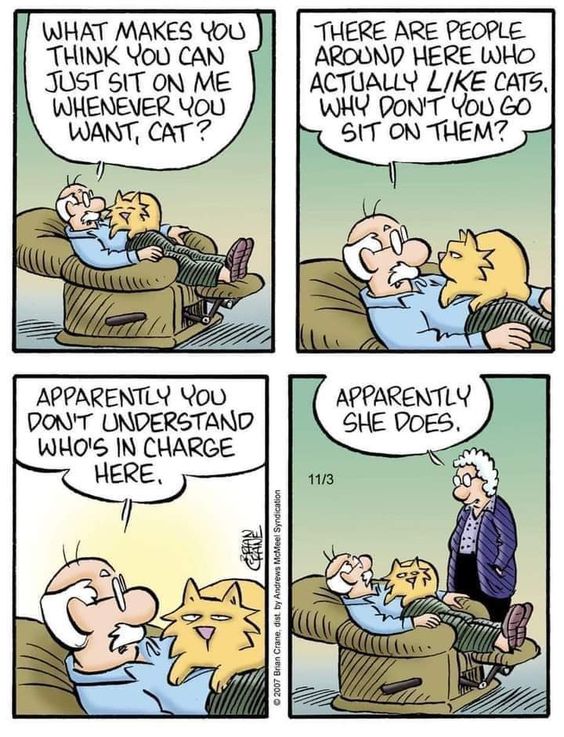
The image is a four-panel comic strip from “Pickles” by Brian Crane. In the first panel, Earl is seen with a cat on his lap, asking the cat what makes it think it can sit on him whenever it wants. In the second panel, Earl suggests to the cat that there are other people who actually like cats and that it should go sit on them instead.
In the third panel, Earl tells the cat that it apparently doesn’t understand who’s in charge, implying that he should be the one deciding whether the cat sits on him. In the final panel, Opal enters the scene and Earl concludes that the cat does understand who’s in charge after all, as it continues to sit on him comfortably. This implies that the cat, and perhaps Opal, are the ones really in charge, not Earl. The strip uses this situation to create a humorous take on pet ownership and the dynamics between pets and their owners, a common theme in Pickles comics.
4
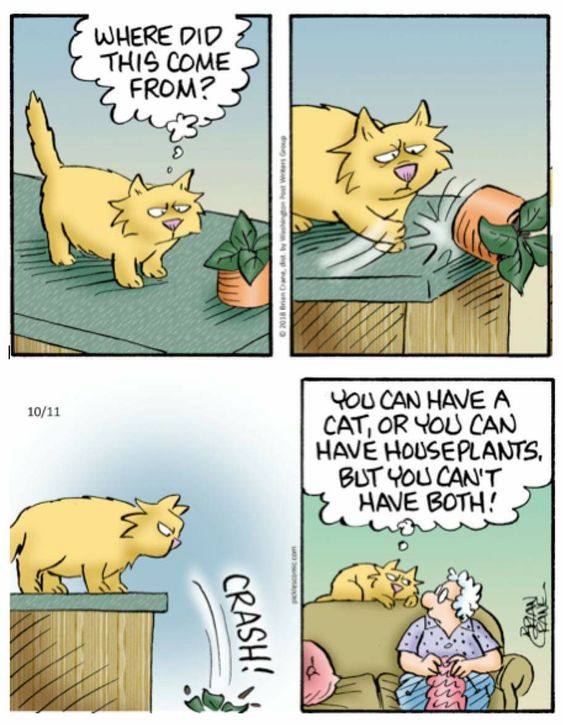
The image is a three-panel comic strip from “Pickles” by Brian Crane. In the first panel, a yellow cat looks curiously at a potted plant, wondering where it came from. In the second panel, the cat is shown tipping the plant over the edge of a raised wooden surface, causing the pot to fall.
In the third panel, we see Earl and Opal, the main characters from Pickles comics, with Earl concluding that one can either have a cat or houseplants, but not both. This is said as the cat looks on nonchalantly from the couch, illustrating the often humorous and destructive curiosity of pets, a common and entertaining theme in Pickles comics.
5
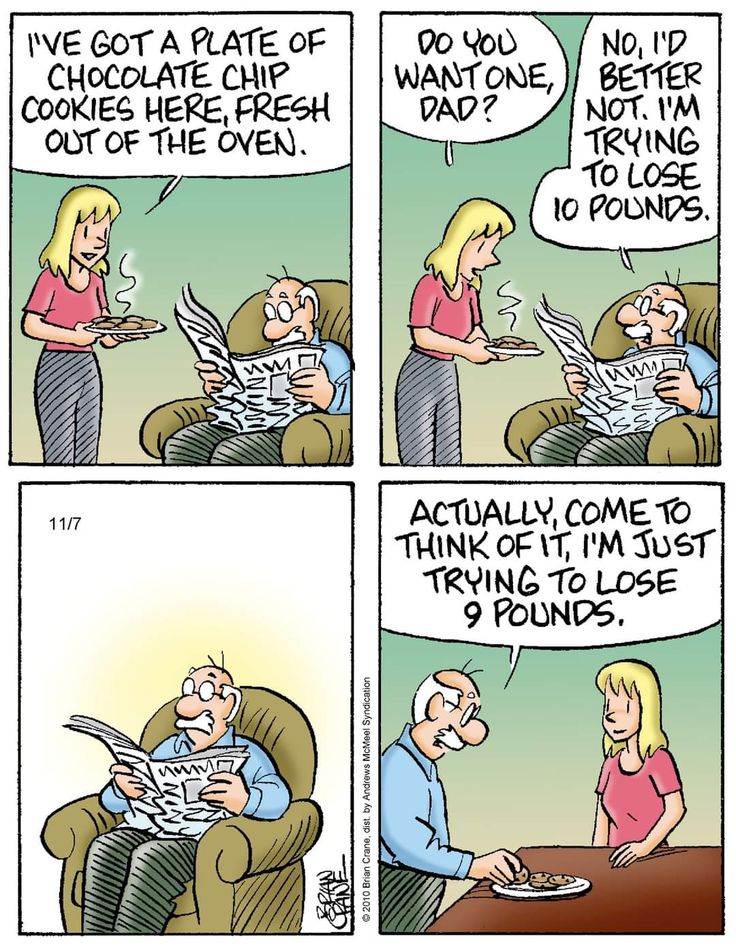
This image is a four-panel comic strip from “Pickles” by Brian Crane. In the first panel, a woman tells Earl, who is reading a newspaper, that she has a plate of chocolate chip cookies fresh out of the oven. In the second panel, she asks Earl if he wants a cookie, to which Earl replies he shouldn’t because he’s trying to lose 10 pounds.
In the third panel, Earl is shown pondering while still reading the newspaper. In the final panel, Earl has a change of heart and tells the woman that, upon reflection, he’s only trying to lose 9 pounds as he walks towards the plate of cookies, indicating he’s decided to indulge in a cookie after all. This comic strip uses humor to depict the common temptation to bend one’s diet rules, a relatable scenario for many readers of Pickles comics.
6

The image is a four-panel comic strip from “Pickles” by Brian Crane. In the first panel, Earl, a character from Pickles comics, is sitting on a bench with another character, and he mentions that food doesn’t taste as good to him as it used to. In the second panel, the other character suggests that this might be because people lose taste buds as they get older.
In the third panel, Earl acknowledges that this could be a possibility with a non-committal “Yeah, could be.” In the final panel, Earl humorously muses that he isn’t sure which he’s losing faster: his brain cells or his taste buds. This comic strip humorously addresses the common concerns of aging, such as the loss of taste and memory, which is a recurring theme in Pickles comics.
7
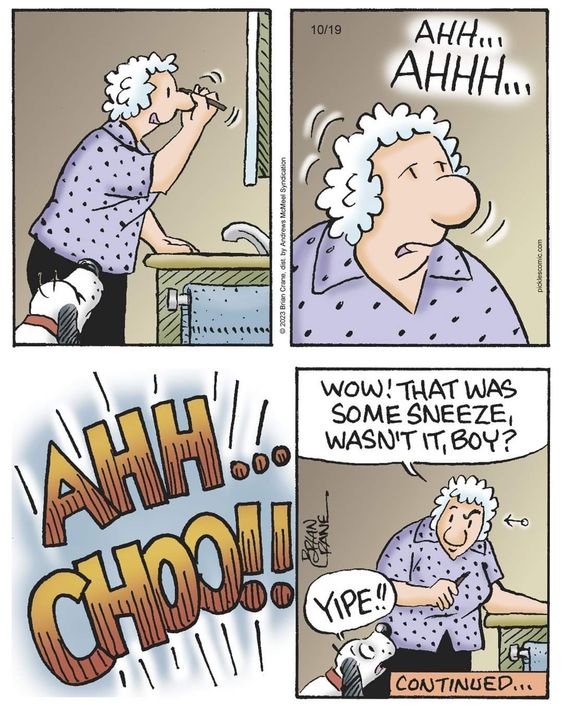
This image is a three-panel comic strip from “Pickles” by Brian Crane. In the first panel, we see Opal, a character from Pickles comics, about to sneeze as she holds a tissue to her nose. In the second panel, Opal is shown from the side with a distressed expression, still on the verge of sneezing.
In the third and final panel, we see a large “AHH CHOO!!” indicating that Opal has sneezed quite loudly. She then looks down at her dog with a bit of surprise and relief, saying, “Wow! That was some sneeze, wasn’t it, boy?” The dog, looking a bit startled, thinks “Yipe!” This comic strip captures a light-hearted moment between Opal and her pet, highlighting the everyday humor that is characteristic of Pickles comics.
8
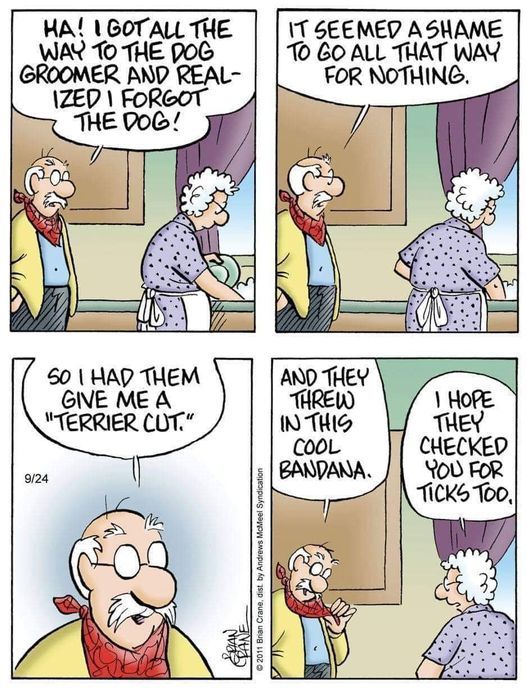
The image is a four-panel comic strip from “Pickles” by Brian Crane. In the first panel, Earl tells Opal that he went to the dog groomer but forgot to bring the dog. In the second panel, he reflects that it would have been a waste to go all that way for nothing.
In the third panel, Earl reveals that he got a “terrier cut,” which is a type of haircut usually given to a terrier breed of dog, for himself instead. In the last panel, he’s wearing a bandana and hopes that they checked him for ticks as well, which is something groomers often do for dogs. This strip plays on the humorous mix-up of Earl visiting the dog groomer without the dog and then whimsically deciding to receive the services himself, capturing the light-hearted and playful spirit that Pickles comics are known for.
9

The image is a four-panel comic strip from “Pickles” by Brian Crane. In the first panel, Earl is sitting with Opal and tells her calmly that he has cut his finger while opening a can of sardines. In the second panel, Opal reacts with concern and asks to see how bad the cut is.
In the third panel, Earl refuses to show his finger, saying it will get blood everywhere and suggests going to the emergency room to get stitches. Finally, in the fourth panel, Opal dismisses the need for stitches and instead offers a Hello Kitty band-aid, believing it will be sufficient to fix the problem. This strip uses humor to portray a typical overreaction to a small household accident and the quirky, down-to-earth solution offered by Opal, a recurring theme in Pickles comics.
10
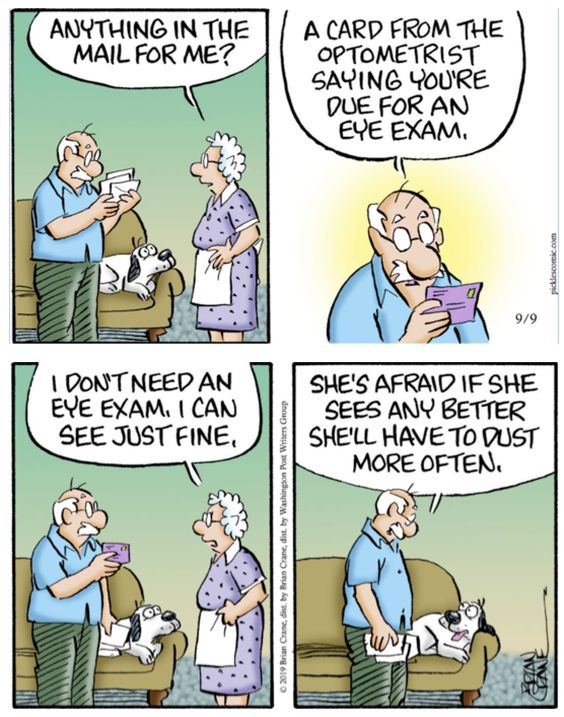
The image is a four-panel comic strip from “Pickles” by Brian Crane. In the first panel, Earl, sitting with his dog, asks Opal if there is anything in the mail for him. Opal responds in the second panel that there’s a card from the optometrist saying Earl is due for an eye exam.
In the third panel, Earl dismisses the need for an eye exam, claiming that he can see just fine. The punchline comes in the fourth panel, where Opal jokingly suggests that Earl is avoiding the eye exam because if his vision improves, he’ll notice the dust around the house and will have to clean more often. This strip uses humor to touch on the common avoidance of medical appointments and the humorous excuses people make, a theme often found in Pickles comics.
Conclusion
Pickles comics by Brian Crane stand as a testament to the enduring power of humor, art, and storytelling. The comic strip transcends the typical boundaries of age and background, offering a universal appeal that resonates with a diverse audience. Through the adventures of Earl, Opal, and their family, Pickles brings laughter, warmth, and a bit of wisdom into the lives of its readers. The comic’s unique blend of humor, relatable characters, and insightful themes ensures that Pickles will remain a cherished part of the comic strip landscape for years to come. As readers, we can look forward to many more years of joy, laughter, and the occasional pickle that life throws our way.

